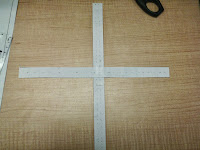If I ask someone how they are feeling and they reply "Oh, average" it is sometimes very difficult for me not to say "Oh, and what sort of average would that be then? Mean? Median? Or mode?" For the record, I do (mostly) refrain from such a comment but it does get me thinking how misunderstood the idea of average is. For example, if I asked you to work out the average of my (ahem) Math Test marks below:
85, 81, 84, 87, 89
...I would imagine that most people would work out the mean and not the median, and I would be very surprised if anyone would work out the mode (and to be honest, why would you with this set of data?) I would also suspect that for those who work out the mean, a majority would do so by adding up the scores and then dividing by 5. With this set of data though, my first instinct is to look at the numbers and think '85 is in the middle of these, so I wonder if I can adjust the other numbers to get as close to 85 as possible?'
I could do this as follows:
Take 4 from the 89 and add it to the 81 so I now have:
85, 85, 84, 87, 85
Now I can take one from the 87 and add it to the 84 to get:
85, 85, 85, 86, 85
Now I can see the extra one on the 86 can be split nicely between the 5 scores:
85.2, 85.2, 85.2, 85.2, 85.2
So I know my mean score is 85.2 and I can do this quickly (without any need for calculations) because I know that the mean is, in effect, the levelling of the scores. This point is often not understood by students even if they have learned the 'add all the scores and divide by the number of scores' formula.
So how can we get students to think of the mean like this? Well suppose a quick survey was done on the number of siblings that six students have and we get the following data: 2, 3, 1, 4, 1, 1. We could represent this as follows:
If we see that we have some scores above 2:
...and then level these out:
then we see that the mean number of siblings (as opposed to the number of mean siblings) is 2.
Now I'm not saying that the mean should be worked out like this every single time but I certainly believe that all students should understand that this is what the mean does.
And this is not just a notion that is helpful in elementary schools. Earlier this year I was working on a Calculus problem as part of my Masters in Mathematics teaching at the University of Waterloo. I had to find the mean width of a semi-circle with radius 1. There is a quite amazing formula (below) that can be used to find this out but I didn't need it.
I relied on the approach above. Knowing that the semi-circle will have an area of
πr²/2 or simply π/2, I realised that to find the mean width I just had to adjust the semi-circle to a rectangle of length 2 with the same area as the semi-circle and from here find out its width.
For good problem solving questions that require students to apply their understanding of the mean, you should look at the University of Waterloo Math Contest site. The one below is from the 2013 Grade 9 Pascal contest.








